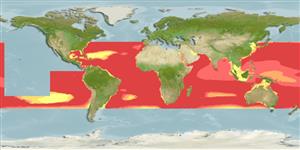Environment: milieu / climate zone / depth range / distribution range
Ecologia
marino batipelagico; distribuzione batimetrica 0 - 2000 m (Ref. 27000). Deep-water; 40°N - 40°S, 180°W - 180°E
Worldwide in tropical and temperate waters (Ref. 33390). Western Atlantic: USA to Argentina. Eastern Atlantic: Azores to South Africa. Indian Ocean: Reunion (Ref. 33390). Southwest Pacific: Australia (Ref. 7300) and New Zealand (Ref. 5755).
Size / Peso / Age
Maturity: Lm ? range ? - ? cm
Max length : 143 cm TL maschio/sesso non determinato; (Ref. 27000)
Pale in color with black lines between vertebrae (Ref. 3248).
Diurnal migrations (Ref. 51024). Feeds on crustaceans. Oviparous, strong sexual dimorphism (Ref. 3247).
Life cycle and mating behavior
Maturities | Riproduzione | Spawnings | Egg(s) | Fecundities | Larve
Smith, D.G., 1990. Nemichthyidae. p. 199-202. In J.C. Quero, J.C. Hureau, C. Karrer, A. Post and L. Saldanha (eds.) Check-list of the fishes of the eastern tropical Atlantic (CLOFETA). JNICT, Lisbon; SEI, Paris; and UNESCO, Paris. Vol. 1. (Ref. 4456)
IUCN Red List Status (Ref. 130435)
Threat to humans
Harmless
Human uses
Pesca: di nessun interesse
Strumenti
Special reports
Download XML
Fonti Internet
Estimates based on models
Preferred temperature (Ref.
123201): 5.4 - 14.9, mean 9 °C (based on 1405 cells).
Phylogenetic diversity index (Ref.
82804): PD
50 = 0.6270 [Uniqueness, from 0.5 = low to 2.0 = high].
Bayesian length-weight: a=0.00102 (0.00046 - 0.00225), b=3.06 (2.88 - 3.24), in cm total length, based on all LWR estimates for this body shape (Ref.
93245).
Trophic level (Ref.
69278): 3.3 ±0.41 se; based on food items.
Resilienza (Ref.
120179): Basso, tempo minimo di raddoppiamento della popolazione 4.5 - 14 anni (Assuming tmax>10).
Fishing Vulnerability (Ref.
59153): Very high vulnerability (86 of 100).
